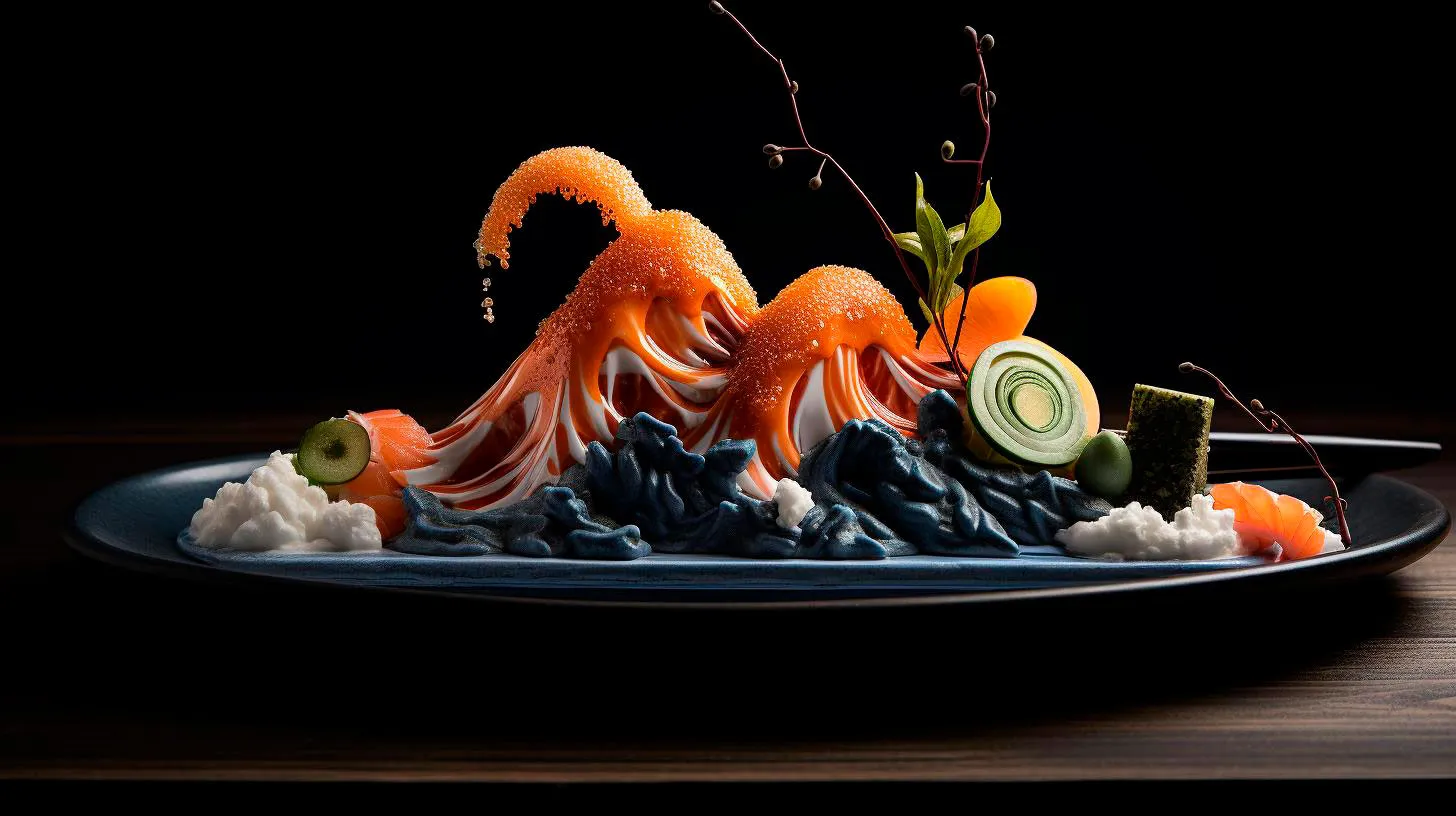Mastering the Art: Discovering the Secrets of Traditional Sushi Making
In this article, we will delve into the art of traditional sushi-making, unveiling its secrets and exploring why it continues to captivate sushi lovers worldwide.
The History of Sushi
Before we dive into the intricacies of sushi making, let’s take a brief trip through its history. Sushi can be traced back to ancient Japan, where it was originally developed as a way to preserve fish. The earliest form of sushi, known as narezushi, involved fermenting fish with rice and salt, which aided in its preservation. Over time, sushi evolved, with new techniques and flavor combinations emerging.
Today, sushi has become a global phenomenon, with various regional and international variations. However, traditional sushi-making techniques still hold a special place in the hearts of sushi connoisseurs.
The Key Ingredients
To master the art of traditional sushi-making, you must first familiarize yourself with the key ingredients. Here are the essential components:
- Sushi Rice: The foundation of any good sushi roll, sushi rice is a short-grain rice seasoned with a delicate blend of vinegar, sugar, and salt. The right balance of flavors gives sushi rice its characteristic taste and texture.
- Seaweed (Nori): Thin sheets of dried seaweed, known as nori, are used to wrap the sushi roll components. Nori adds a unique umami flavor and provides structural support to keep the roll intact.
- Fish and Seafood: The choice of fish and seafood is crucial in sushi-making. From fatty tuna and salmon to succulent shrimp and eel, each ingredient brings its own distinct flavor profile.
- Vegetables and Other Fillings: Sushi rolls often incorporate various vegetables such as cucumber, avocado, or pickled radish, adding freshness and crunchiness to balance the flavors.
- Condiments: Soy sauce, wasabi, and pickled ginger are indispensable condiments that enhance the taste of sushi. These accompaniments add an extra layer of flavor and provide a burst of heat and tanginess.
The Techniques
While mastering the techniques of traditional sushi-making requires practice and patience, understanding the basic steps is essential. Here’s an overview of the key techniques involved:
- Sushi Rice Preparation: Properly washing and cooking the sushi rice is crucial. Once cooked, the rice is seasoned with sushi vinegar, which adds a tangy and slightly sweet taste.
- Rolling Techniques: There are different types of sushi rolls, such as maki, nigiri, and temaki. Each requires specific rolling techniques to achieve the desired shape and presentation.
- Knife Skills: Precise knife skills are vital to creating visually appealing sushi. The fish should be sliced evenly and at the right angle to enhance both the taste and aesthetics of the final dish.
- Presentation: Traditional sushi-making places great emphasis on presentation. Arranging the sushi pieces elegantly on a plate and garnishing them with fresh ingredients elevates the dining experience.
The Advantages of Traditional Sushi Making
Mastering the art of traditional sushi-making offers various advantages:
- Cultural Appreciation: Traditional sushi-making allows you to connect with the rich culture and heritage of Japan. It’s an opportunity to pay homage to the generations of sushi masters who have perfected their craft.
- Health Benefits: Sushi is widely regarded as a healthy choice due to its emphasis on fresh, quality ingredients. By making your own sushi, you have full control over the ingredients used, enabling you to craft a healthy and nutritious meal.
- Culinary Creativity: Traditional sushi-making is not only about following a recipe; it opens doors to culinary creativity. Experimenting with different fillings, flavors, and presentations allows you to personalize your sushi creations based on your preferences.
Key Takeaways
As you embark on your journey to master the art of traditional sushi-making, keep these key takeaways in mind:
- Practice, practice, practice! Traditional sushi-making requires patience, precision, and perseverance.
- Invest in quality ingredients. Fresh fish, vegetables, and condiments are crucial for creating an unforgettable sushi experience.
- Embrace creativity. Don’t be afraid to experiment with different flavors and presentation styles to add your own unique touch.
- Enjoy the process. Making sushi is an art form, and the joy lies in the creation and, of course, the delightful taste.
By exploring the secrets of traditional sushi-making, you can elevate your culinary skills and create sushi rolls that truly reflect the essence of this ancient Japanese delicacy. So, don your apron, grab your sushi mat, and embark on a journey of flavor, tradition, and creativity!
Japanese Fast Food Chains Innovating while Preserving Traditional Techniques
In this article, we will delve into the fascinating world of Japanese fast food chains and explore how they are revolutionizing the industry.
The Blend of Innovation and Tradition
Japanese fast food chains understand the importance of staying true to their roots while adapting to modern consumer demands. These chains have embraced technological advancements without compromising on the traditional cooking techniques that have been honed over centuries. By combining innovation and tradition, they create unique offerings that cater to a wide range of tastes and preferences.
Let’s explore some of the key aspects that distinguish Japanese fast food chains from their international counterparts:
1. Quality Ingredients
Japanese fast food chains prioritize the use of high-quality ingredients, ensuring that every bite is a delightful experience. From locally sourced vegetables to premium-grade meats, these chains take immense pride in sourcing the best ingredients available. This commitment to quality shines through in their dishes and sets them apart from other fast food chains.
2. Traditional Cooking Techniques
While embracing innovation, Japanese fast food chains remain deeply rooted in traditional cooking techniques. These techniques have been passed down through generations and involve meticulous attention to detail. By integrating these techniques into their operations, these chains preserve the authenticity and depth of flavor that Japanese cuisine is known for.
3. Healthy Options
Recognizing the growing demand for healthier food choices, Japanese fast food chains have developed a range of nutritious offerings. They utilize fresh ingredients, minimize the use of artificial additives, and offer customization options to cater to individual dietary preferences. This focus on health appeals to health-conscious consumers and contributes to their overall satisfaction.
4. Unique Menu Offerings
Japanese fast food chains are known for their diverse and innovative menus. While staples like sushi, ramen, and tempura feature prominently, these chains continuously introduce new and exciting dishes. They often collaborate with renowned chefs or local producers to create limited edition items, offering customers a fresh and enticing experience.
The Advantages of Japanese Fast Food Chains
Japanese fast food chains offer a plethora of advantages that make them stand out in the industry. These advantages include:
- Efficiency: Japanese fast food chains are renowned for their efficiency in serving customers quickly without compromising on food quality.
- Hygiene and Safety: The meticulous attention to cleanliness and safety measures ensures that customers can enjoy their meals with peace of mind.
- Attention to Detail: From packaging designs to food presentation, Japanese fast food chains pay meticulous attention to detail, enhancing the overall dining experience.
- Customer Satisfaction: The combination of traditional techniques, quality ingredients, and innovative offerings results in high customer satisfaction and loyalty.
Key Takeaways
Japanese fast food chains have successfully embraced innovation while upholding traditional techniques, resulting in a unique and enticing dining experience. Key takeaways from their approach include:
- Prioritizing quality ingredients to deliver exceptional flavors.
- Preserving traditional cooking techniques to maintain the authenticity of Japanese cuisine.
- Offering a wide range of healthy options to cater to varying dietary preferences.
- Continuously introducing new and inventive dishes to captivate customers.
- Providing efficient service, impeccable hygiene, and attention to detail for a satisfying dining experience.
Japanese fast food chains have mastered the art of innovation while preserving traditional techniques. By combining these elements, they create an unmatched culinary experience that tantalizes the taste buds of customers worldwide. So, the next time you grab a quick bite from a Japanese fast food chain, savor the flavors and appreciate the seamless blend of ingenuity and tradition.
The Art of Sushi: Unveiling Japan’s Culinary Masterpiece
In this article, we would dive into the world of sushi, exploring its history, techniques, and key features that make it a truly unique culinary experience.
The History of Sushi
Sushi has a rich history that dates back over a thousand years. Originally, in ancient Japan, sushi referred to the process of fermenting fish with rice for preservation. It was a method developed to store fish for prolonged periods. Over time, this technique evolved, and the rice started being consumed along with the fish.
During the Edo period (1603-1868), sushi stalls started appearing in Japan’s bustling cities, making it more accessible to the public. This marked the transition of sushi from being just a preservation technique to a beloved culinary experience. Today, sushi has gained global recognition, with various regional variations and international adaptations.
Sushi Techniques
Creating sushi is an art form that requires precision, patience, and skill. Here are some essential techniques that sushi chefs master:
- Nigiri: This technique involves molding small portions of vinegared rice by hand and topping them with fresh seafood or other ingredients. The result is bite-sized sushi pieces that are visually appealing and bursting with flavor.
- Maki: Maki refers to sushi rolls where the rice and fillings are wrapped in a sheet of seaweed (nori). The roll is then sliced into bite-sized pieces. Maki rolls provide an excellent canvas for creativity, with endless options for fillings and combinations.
- Sashimi: Unlike typical sushi, sashimi comprises only thinly sliced raw fish or seafood, served without rice. It showcases the natural flavors of the main ingredient and requires expert knife skills to ensure precise cuts.
The Key Features
Sushi’s allure lies not only in its flavors but also in its unique features and presentation. Here are some key highlights:
- Freshness: Sushi is synonymous with freshness. The use of high-quality, impeccably fresh seafood is essential to ensure the perfect sushi experience.
- Presentation: Sushi is not only a treat for the taste buds but also a feast for the eyes. Its presentation is meticulous and visually appealing, with each piece crafted with artistry and attention to detail.
- Umami: Sushi embodies the balance of flavors, especially umami. Umami is considered the fifth taste, characterized by savory and rich notes that elevate the overall taste experience of sushi.
- Dipping Sauce: The accompaniments that enhance the sushi experience include soy sauce, wasabi, and pickled ginger. These condiments add depth and bring out the flavors of the sushi.
The Advantages of Sushi
Sushi brings numerous advantages to the table that make it a preferred choice among food enthusiasts. Here are a few notable benefits:
- Healthy Option: Sushi is generally considered a healthier choice compared to many other dishes. It is low in saturated fats, rich in lean proteins, and often incorporates nutrient-rich ingredients like seaweed, fish, and vegetables.
- Dietary Diversity: Sushi caters to a wide range of dietary preferences and restrictions. With options like vegetarian sushi, gluten-free rolls, and fish alternatives, there is something for everyone.
- Quick and Convenient: Sushi is a perfect grab-and-go option for those with a busy lifestyle. Many sushi restaurants and establishments offer take-out or delivery services, making it a convenient choice for a delicious meal.
- Social Experience: Sharing a sushi platter with friends or family fosters a sense of community and creates an enjoyable dining experience. Sushi’s small, bite-sized portions make it ideal for communal dining.
The Takeaway
Sushi is not merely a dish; it’s an art form that showcases the rich culinary heritage of Japan. Its history, meticulous techniques, and distinctive features contribute to a sensory experience that captivates food enthusiasts worldwide. Whether you are a seasoned sushi connoisseur or a curious beginner, exploring the world of sushi is bound to be a journey filled with unique flavors, cultural discoveries, and an appreciation for the artistry behind this culinary masterpiece.
From Samurai to Sushi: Exploring the History and Evolution of Japanese Cuisine
In this blog article, we will delve into the fascinating history and evolution of Japanese cuisine, tracing its journey from the era of samurai warriors to the modern-day sushi revolution.
The Roots of Japanese Cuisine
Japanese cuisine can be traced back thousands of years, influenced by a combination of local ingredients, cultural practices, and foreign influences. Here are some key highlights of its evolution:
- Prehistoric Era: The early Japanese diet primarily consisted of fish, hunted game, and gathered plants.
- Buddhist Influence: In the 6th century, Buddhist monks introduced the concept of vegetarianism, influencing the development of unique vegetarian dishes such as shojin ryori.
- Samurai and Feudal Japan: During this time, the diet of samurai warriors emphasized the consumption of rice, seafood, and pickled vegetables, laying the foundation for what would become traditional Japanese cuisine.
The Arrival of Foreign Influences
As Japan opened up to trade and cultural exchange with other countries, foreign influences significantly impacted its cuisine. Here are some notable examples:
- Chinese Influence: The introduction of Buddhism from China in the 6th century brought new cooking techniques, seasonings, and ingredients, such as soy sauce and tofu.
- European Influence: In the 16th century, Portuguese traders brought new ingredients like tempura and introduced the concept of batter-frying.
The Rise of Sushi
Perhaps the most iconic and internationally recognized Japanese dish is sushi. Dating back to the 8th century, sushi has undergone various transformations throughout history. The key milestones include:
- Narezushi: This precursor to modern sushi was developed during the Muromachi period (1336-1573) and consisted of fermenting fish with rice, creating a preservation technique.
- Edo-Mae Sushi: In the 19th century, sushi as we know it today emerged during the Edo period. Vinegar-infused rice and fresh fish were combined to create the nigiri-zushi style, popular in Tokyo.
- Modern Sushi: After World War II, sushi underwent a significant transformation, becoming more accessible and affordable. The introduction of conveyor belt sushi (kaiten-zushi) revolutionized the sushi dining experience.
Key Takeaways and Advantages
Understanding the history and evolution of Japanese cuisine brings several advantages and takeaways, both for food enthusiasts and aspiring chefs:
- Cultural Appreciation: Exploring the historical roots of Japanese cuisine allows you to appreciate the rich cultural heritage behind each culinary creation.
- Ingredient Diversity: Japanese cuisine showcases an incredible range of ingredients, including fresh seafood, vegetables, and unique seasonings.
- Health Benefits: The emphasis on fresh ingredients, balanced flavors, and mindful cooking techniques make Japanese cuisine a healthy choice.
- Artistic Presentation: Japanese dishes are known for their beautiful and meticulous presentation, showcasing the artistry and attention to detail.
- Sustainability: Japanese cuisine traditionally embraces seasonal and local ingredients, promoting sustainability and minimizing environmental impact.
With its deep-rooted traditions, innovative techniques, and unforgettable flavors, Japanese cuisine continues to captivate food lovers worldwide. From the samurai era to the sushi revolution, the evolution of Japanese cuisine reflects the dynamic nature of culinary traditions. So why not take a trip to your favorite Japanese restaurant and embark on a culinary journey that spans centuries?



